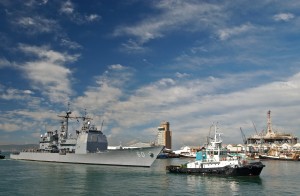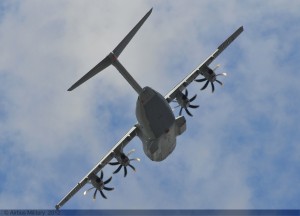2013-06-05
With our new partnership with Defence Web, we will bring our readers from time to time articles from our partner which highlights developments of interest to our U.S. and global readers.
A key theme for Second Line of Defense is shaping 21st century forces for 21st century missions.
In the case of South Africa, the government has not adequately funded South African defense forces, but the challenge is to move forward in spite of this to shape a template for moving forward.

In this article, Helmoed Römer Heitman provides an interesting look at a reform effort, which could put in motion a new template to address South African needs and interests.
SANDF: Optimal Force Design
The ‘Battle of Bangui’ in the Central African Republic in March and its aftermath should cause government to think about what sort of Defence Force South Africa needs. While the troops fought magnificently, the Defence Force had no means of either promptly reinforcing or extracting them. A similar challenge could have arisen in November when M23 rebels occupied Goma in the DRC.
South Africa cannot afford to become involved in security matters on the continent when the defence budget does not allow for it.
This article sets out one possible interim force design allowing the South African National Defence Force (SANDF) to execute its present missions and develop a small contingency reserve.
Essentially the Defence Force would be able to:
• Patrol and protect our land borders, maritime borders and zones (including islands) and airspace.
• Patrol shipping routes critical to South Africa, for instance the Mozambique Channel;
• Support the Police in anti-terrorist operations;
• Respond effectively to threats to vital external interests, for instance the Khatse Dam in Lesotho and the Cahora Bassa power station and Maputo harbour in Mozambique;
• Conduct small non-combatant evacuations, for instance embassy staff;
• React promptly at combat-group strength with air and naval support to a security crisis within the SADC or in an adjacent country, with follow-on forces for twelve months;
• Sustain the current peace support commitments in Darfur and the DRC;
• Maintain a contingency force of approximately brigade strength and equivalent reserve capacity in the Air Force and Navy.
What does this translate into in terms of actual force elements?
Army
The Army will need to be expanded somewhat to allow proper rotation – 1 in 4 is the highest sustainable tempo – for peace operations, patrolling the border and having rapid deployment and contingency forces.
Considering this by tasks, we might have the following structure:
| Task Force | Requirement |
| Border Protection | 8 dedicated/mission-tailored battalions and 1 specialist battalion, grouped into geographic sectors |
| Quick Reaction/Rapid Deployment Force | 1 airborne brigade (air assault, parachute and air-landed battalion groups) 1 motorised/mechanised battalion group (Drawn from the reinforced mechanised brigade.) |
| Peace Support Commitments | 1 light mechanised brigade, 1 motorised brigade |
| Contingency Force | 1 reinforced mechanised brigade |
The airborne brigade would provide crisis response capability in conjunction with the Special Forces.
The light mechanised and motorised brigades would each be responsible for a particular peace support mission (4 infantry battalion groups each, mechanised and motorised infantry, plus support units). The former would deal with Darfur, the latter the DRC, or later with other missions in regions suited to their capabilities.
The mechanised brigade would serve as the main contingency force and would include a tank regiment, forming basis on which to build a stronger force in the future, and would provide heavy units should one of the above brigades become involved in peace enforcement.
The Army could then also establish a small tactical division HQ to command a multi-brigade operation if necessary. As funding allows, reserve units could be brought back to operational status to provide additional short-term capacity.
Navy
| Task Force | Requirement |
| Surveillance Patrols | 4 attack submarines (2-3 operational) |
| Mainland EEZ Patrol | 6 offshore patrol vessels (4-5 operational) |
| Distant Patrols (Mozambique Channel, West African waters, Marion/Prince Edward Islands ) and Contingency Task Force | 8 frigates, 3 combat support ships (5-6 frigates and 2 support ships operational) |
| Port Security | 1 task-tailored unit per port. |
Other fleet possibilities include 8 OPVs and 6 frigates, or 6 OPVs, 4 frigates and 4 ocean patrol vessels.
None of these fleet designs would provide any ability to deploy forces by sea, except Special Forces elements.
That capability would have to be added later, although it could be possible to acquire three LHD type vessels designed to also serve as combat support ships.
That would provide an adequate sealift capability for most situations, albeit tight when one is in refit.
Air Force
| Task Force | Requirement |
| Air Space Surveillance and Defence | Static and deployable radars 6 Gripen available (The total requirement for Gripens available for operations comes to 24, which would normally require a fleet of about 34, but some missions could be handled by Hawks in the interim.) |
| Maritime Surveillance and Patrol | 8 coastal surveillance aircraft 6 long-range surveillance aircraft (eg HC-130J) 18 shipboard helicopters (Super Lynx) |
| Border Surveillance and Patrol | 6 surveillance aircraft (optronic and other sensors) |
| Air Assault | 12 Oryx available in SA 12 Oryx available for peace operations (This will require a fleet of 34 aircraft; an additional 6 aircraft will be required for the Navy’s support ships, and at there should be at least 6 additional aircraft fully equipped for Special Forces operations, making a minimum fleet of 46 aircraft.) |
| Parachute, Air Landed and Special Forces Operations | 12 heavy/long-range transports (eg A400M) 6 medium transports (eg C-130J) 12 light transports (eg C-27J) |
| Deployable Close Air Support | 6 Rooivalk available in SA 6 Rooivalk deployed for a peace mission (The Rooivalk requirement would normally require a fleet of at least 18, and is a minimum for the mechanised force to be credible and allows for only one peace mission. There is a major shortfall here.) |
| Reconnaissance/Strike Force Reconnaissance | 6 Gripen available in SA 6 Gripen available for deployment |
| Deployable Combat Air Patrol | 6 Gripen (eg ‘no fly’ zone over Darfur) |
| Aerial Refuelling | 4 multi-role tanker/transport aircraft (These would be multi-role aircraft for use as tankers and long-haul transport, and convertible for VIP tasks). |
Looking forward, one would like to add airborne radar capability and to expand the airlift to be able to deploy a parachute battalion group in a single lift and an air-landed battalion within 48 hours. There is also a clear need for some heavy lift helicopters.

Special Forces
The Special Forces are too small if South Africa is to play an effective regional security role. There is also a case to be made for returning to the previous approach of specialised units for urban operations, rural operations and maritime operations.
The Cost
The total force package outlined here would cost in the region of R60 billion per year, assuming that the equipment was acquired over a ten-year period – about R25 billion for the Army, R6 billion for the Navy, R10 billion for the Air Force and R500 million for the Special Forces. The remainder would cover overheads, including the Military Health Service and joint training establishments.
That is 50% up on the present budget, but would allow the Defence Force to meet its current commitments and have a reserve. Also, much of the additional funding would be spent inside South Africa on salaries and locally manufactured equipment, so being an additional cost to the Treasury but not necessarily a full cost to the country.
Published originally on 5/9/13

